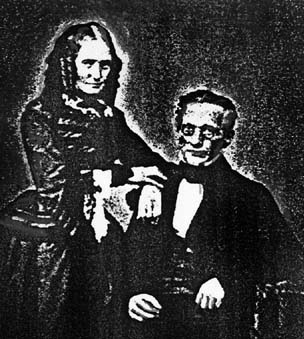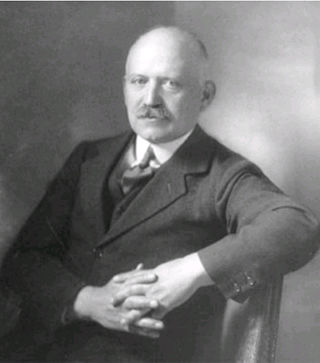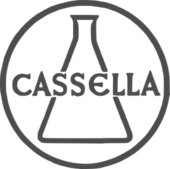
I. G. Farbenindustrie AG, commonly known as IG Farben, was a German chemical and pharmaceutical conglomerate. Formed in 1925 from a merger of six chemical companies—BASF, Bayer, Hoechst, Agfa, Chemische Fabrik Griesheim-Elektron, and Chemische Fabrik vorm. Weiler Ter Meer—it was seized by the Allies after World War II and divided back into its constituent companies.

Hoechst AG was a German chemicals then life-sciences company that became Aventis Deutschland after its merger with France's Rhône-Poulenc S.A. in 1999. With the new company's 2004 merger with Sanofi-Synthélabo, it became a subsidiary of the resulting Sanofi-Aventis pharmaceuticals group.
Sanofi S.A. is a French multinational pharmaceutical and healthcare company headquartered in Paris, France. Originally, the corporation was established in 1973 and merged with Synthélabo in 1999 to form Sanofi-Synthélabo. In 2004, Sanofi-Synthélabo merged with Aventis and renamed to Sanofi-Aventis, which were each the product of several previous mergers. It changed its name back to Sanofi in May 2011. The company is a component of the Euro Stoxx 50 stock market index.
The American IG Chemical Corporation, or American IG, for short, was an American holding company incorporated under the Delaware General Corporation Law in April 1929 and headquartered in New York City. It had stakes in General Aniline Works (GAW), Agfa-Ansco Corporation, and Winthrop Chemical Company, among others, and was engaged in manufacture and sale of pharmaceuticals, photographic products, light weight metals, synthetic gasoline, synthetic rubber, dyes, fertilizers, and insecticides. The Moody's industrial manual listed an affiliation between IG Farben and American IG at the time of founding. First, Hermann Schmitz, who was the second after Carl Bosch in IG Farben's hierarchy, and then his brother Dietrich A. Schmitz served as American IG's presidents. It was re-incorporated as General Aniline & Film (GAF) Corp. in 1939 after a merge with General Aniline Works.

Höchst is a quarter of Frankfurt am Main, Germany. It is part of the Ortsbezirk West.

King Pharmaceuticals, is a pharmaceutical company, a wholly owned subsidiary of Pfizer based in Bristol, Tennessee. Before being acquired by Pfizer, it was the world's 39th largest pharmaceutical company. On October 12, 2010, King was acquired by Pfizer for $14.25 per share. King produced a wide range of pharmaceuticals, including Altace for heart attack prevention, Levoxyl for hypothyroidism, Sonata, a sleeping aid, and Skelaxin, a muscle relaxant. King Pharmaceuticals operated manufacturing facilities in Bristol, Tennessee; Rochester, Michigan; St. Louis, Missouri; St. Petersburg, Florida; and Middleton, Wisconsin. They employed approximately 2,700 people including a sales force of over 1,000 individuals.

Roussel Uclaf S.A. was a French pharmaceutical company and one of several predecessor companies of today's Sanofi.

Clariant AG is a Swiss multinational speciality chemicals company, formed in 1995 as a spin-off from Sandoz. The company is focused on four business areas: care chemicals ; catalysis; natural resources ; and plastics & coatings. Headquartered in Muttenz, Switzerland, the public company encompasses 110 operating companies in 53 countries. Major manufacturing sites are located in Europe, North America, South America, China, and India. In 2015, sales from continuing operations were 5.8 billion CHF.
Rhône-Poulenc was a French chemical and pharmaceutical company founded in 1928. In 1999 it merged with Hoechst AG to form Aventis. As of 2015, the pharmaceutical operations of Rhône-Poulenc are part of Sanofi and the chemicals divisions are part of Solvay group and Bayer Crop Science.
Marion Merrell Dow and its predecessor Marion Laboratories was a U.S. pharmaceutical company based in Kansas City, Missouri, from 1950 until 1996.
May & Baker was a British chemical company founded by John May and William Gerrard Baker in Wandsworth, London in 1839. They initially specialized in the manufacture of chemicals derived from mercury and bismuth. Over the years they diversified into other chemical fields including photographic chemicals, pharmaceuticals, agrochemicals, and chemicals for research and development.

Carl Johann Eugen de Haën, often known as Eugen de Haën or Eugen de Haen, was a German chemist and entrepreneur. He was founder of the chemistry factory E. de Haën & Co.
Hoechst Schering AgrEvo GmbH was a Düsseldorf-based limited liability company owned by Hoechst AG and Schering AG that only existed as an independent company for five years, from 1994 to 1999.

Leopold Cassella was a German businessman, known for having founded the company Cassella, one of many predecessor companies of today's Sanofi.
Adolf Stachel was a German chemist, researcher and inventor, who worked as a researcher at the chemical and pharmaceutical company Cassella in Frankfurt-Fechenheim for much of his career.

The Gans family is a prominent German family of industrialists and philanthropists from Frankfurt am Main. It is descended from Ludwig Aaron Gans, a Jewish businessman from Celle, who became an apprentice in the firm Caßel & Reiß in Frankfurt in 1814. In 1828, he married Rosette Goldschmidt (1805–1868), a niece and adopted daughter of the firm's owner Leopold Cassella, and was accepted as a partner of the firm. In 1848, Gans became sole owner of Leopold Cassella & Co., as the company was then named. Ludwig Aaron Gans was the father of the major industrialist Friedrich Ludwig von Gans, who was ennobled in 1912, and of the chemist and industrialist Leo Gans. The family converted from Judaism to Protestantism in the late 19th century.

Ludwig Aaron Gans was a German industrialist and owner of the company Cassella.
Werner Zerweck was a German chemist, inventor and industrial leader, who served as CEO of the chemical and pharmaceutical company Cassella from 1953 to 1963. Under his leadership the company focused increasingly on pharmaceuticals and cosmetics rather than its former primary focus, dyes. He was also a member of the advisory board of Deutsche Bank from 1953. Zerweck was one of the pioneers in the development of synthetic fibers.

Carl von Weinberg was an important Jewish German chemist, entrepreneur, patron of the arts and philanthropist.














